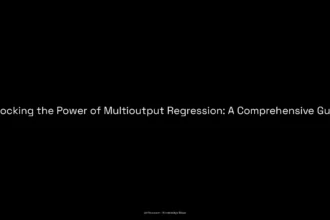Are you ready to dive into the fascinating world of class distribution in machine learning? Brace yourself for a rollercoaster ride as we unravel the mysteries of skewed data and its implications. Whether you’re a data enthusiast or a curious learner, this blog post will equip you with the necessary tools to tackle the challenges of class distribution head-on. Get ready to explore the role of Python, the power of the median, and the intricacies of data class attributes. So, buckle up and join us on this exhilarating journey through the realm of class distribution. Let’s get started!
Table of Contents
ToggleUnderstanding Class Distribution in Machine Learning
Class distribution is a cornerstone of machine learning, particularly when it comes to the realm of classification problems. Imagine a dictionary, not one filled with words, but with numbers that guide the journey of algorithms. This is what a class distribution looks like: a dictionary where the key is the class value, such as ‘0’ for benign and ‘1’ for malignant in a cancer detection dataset, and the value is the number of instances that belong to that class.
| Date | Class Distribution Definition | Class Interval Formula | Skewed Class Distribution | Dealing with Skewness | Resolving Class Imbalance | Creating Class Distribution |
|---|---|---|---|---|---|---|
| Jan 14, 2020 | A dictionary with class values as keys and example counts as values. | Upper-class limit – Lower class limit | Significant percentage difference between classes in a dataset. | Implement resampling techniques. | Creating a new training dataset with a modified class distribution. | Range = Maximum – Minimum |
In the vibrant landscape of data, class distribution is akin to understanding the population dynamics of a city. It tells you about the prevalence of each category—how common or rare each outcome is. For instance, in a balanced dataset, you might find an equal number of positive and negative examples, much like a town with an equal number of restaurants and shops.
However, the real world is seldom perfectly balanced. Often, we encounter skewed class distributions, where one class overwhelmingly outnumbers the other. This is like a town brimming with restaurants yet having only a handful of shops. In machine learning, this could be a fraud detection dataset with a large number of legitimate transactions (class ‘0’) and a small number of fraudulent ones (class ‘1’).
Understanding class distribution is not merely an academic exercise—it has real implications for model performance and evaluation. Models trained on imbalanced data may develop a bias, preferring the majority class, and thus fail to recognize the minority class effectively. This could be catastrophic, for instance, in medical diagnosis, where failing to detect a rare disease could mean overlooking a critical condition.
So, how does one navigate this skewed landscape? To align the scales, strategies such as resampling are employed. This involves either oversampling the minority class or undersampling the majority class to achieve a more balanced distribution, much like a city planner might decide to promote shop development or curb the growth of restaurants.
Creating a class distribution requires a meticulous approach, akin to an artisan crafting a mosaic. One starts by identifying the range of the data, which is the difference between the largest and smallest values, and then deciding on a strategy to either broaden or narrow the class intervals, shaping the dataset into a more useful form for predictive modeling.
In essence, class distribution is the map that guides us through the intricate terrain of machine learning. By understanding and appropriately adjusting the distribution of our classes, we pave the way for algorithms to learn more effectively, making accurate predictions that can transform industries and save lives.
Skewed Class Distribution: An Overview
Imagine walking into an orchard filled predominantly with apple trees, with only a few scattered orange trees. This is akin to encountering a skewed class distribution in a dataset, a common scenario where the frequencies of occurrence among classes are disproportionate. This imbalance can significantly impact the performance of machine learning models, often leading to predictions that are biased towards the more prevalent class.
In the realm of data, skewed distributions can take on two distinct forms: positively skewed or negatively skewed. Much like the way the branches of a tree might lean more heavily to one side, these distributions reveal an asymmetry in the data. Where the bulk of data points congregate can reveal much about the underlying patterns and potential biases within.
When the tail of the distribution extends more substantially to the right, we witness a positive skew. This scenario is akin to finding that most apples in our hypothetical orchard are clustered near the entrance, with a few outliers farther away. Conversely, a negative skew indicates that the heavier tail drifts to the left, suggesting an abundance of data points with higher values and fewer with lower ones.
Understanding skewness is not simply a matter of recognizing the direction in which the data leans. It is a deep dive into the story the data tells. A positively skewed distribution whispers tales of outliers stretching the narrative to the right, showcasing a greater concentration of smaller values with occasional larger ones casting long shadows. This skewness informs us that the data does not center around the average but is pulled by the gravity of the outliers.
In the world of machine learning, skewed class distributions present a unique challenge. Take, for example, the pressing issue of cancer classification. If in a dataset, only 1% of the subjects have cancer (y = 1) while the remaining 99% do not (y = 0), then the class distribution is severely skewed. Such an imbalance can lead to a model that is overly confident in predicting the non-cancer class, potentially overlooking crucial cases of the disease.
To navigate through the orchard of skewed data, it is imperative that we adjust our path. We must employ strategies to ensure that our models are not blinded by the abundance of one class over another. Techniques like resampling the minority class, using specialized performance metrics, or applying cost-sensitive learning become the orchardist’s tools, meticulously crafted to cultivate a more balanced dataset for robust classification.
As we delve deeper into the nuances of skewed data, we’ll explore how to effectively address these imbalances and ensure our machine learning models perform with the precision of a seasoned orchardist, capable of identifying every apple and orange with equal care.
With this overview, we set the stage for a deeper exploration of the implications of skewness and the strategies to confront it, ensuring that our journey through the orchard of data is both fruitful and enlightening.
Implications of Skewness
Imagine yourself as an orchard keeper, with each fruit representing a piece of data in your distribution. In an ideal world, the fruits would be evenly dispersed across your trees, symbolizing a balanced dataset. However, the reality of skewness in data is akin to finding more fruit on one side of the orchard than the other. This imbalance has profound implications, particularly in areas like finance, where the distribution of returns can resemble the unpredictable nature of a bountiful or barren harvest.
Consider a positively skewed distribution in the financial realm. It’s akin to anticipating a windfall of apples on the furthermost tree, with fewer fruits as you approach the orchard’s entrance. This statistical configuration suggests that while most investors will experience moderate gains, there’s a tantalizing possibility of a significant windfall for a few—a promising prospect for those with an appetite for risk.
Delving into the heart of skewness, it’s crucial to recognize what the tail of the distribution whispers about potential outliers. In a positively skewed scenario, the extended right tail beckons with the siren call of exceptional profits, but it also murmurs the cautionary tale of rare yet severe losses. It’s a lopsided world of data where the mean, like an overladen branch, is pulled away from the median and towards these extraordinary outcomes.
Skewness isn’t just a statistical characteristic—it’s a storyteller, revealing the underlying narrative of the data. In a positively skewed distribution, the majority of data points cluster towards the left, suggesting a congregation of common, less extreme values. The elongated right tail, however, indicates that outliers are not just present but significantly distant from the norm. It’s a tale of an economic climate where the ordinary is common, but the chance for remarkable success, though rarer, cannot be ignored.
Understanding skewness is akin to interpreting the subtle signs nature provides. Just as a seasoned farmer reads the skies to predict the weather, a shrewd analyst scrutinizes the skewness in data to anticipate market trends. The distribution’s asymmetry provides a lens through which the potential risks and rewards of investments become clearer, guiding decisions in portfolio management and risk assessment.
In essence, skewness offers a glimpse into the future, albeit with a hint of uncertainty. It lays bare the propensity for anomalies and guides us in preparing for them. Whether in finance, marketing, or any field where data-driven decisions reign supreme, acknowledging and interpreting skewness is the key to harvesting the fruits of success while remaining vigilant of the potential for loss.
As we continue our voyage through the orchard of data, let us not forget the importance of understanding the implications of skewness. It is not merely a statistical curio but a beacon that illuminates the path of future possibilities in a world that thrives on information.
Dealing with Skewed Data
In the journey of data exploration, we often encounter the winding roads of skewed distributions. Much like a storyteller that prefers complex characters over straightforward ones, skewed data adds richness to our narrative, but it also introduces challenges. It’s essential to address these challenges head-on, especially in classification problems where the assumption of normality underpins many machine learning algorithms.
Imagine a situation where the data at hand is a treasure trove of information with a catch: the majority of the riches are buried in rarely occurring, yet highly significant, extreme values. This is where transformation techniques step in, serving as the alchemists turning skewed data into a more ‘normal’ state. Among these techniques is the log transformation, a powerful spell that can tame the wild, positively skewed distributions, rendering them more symmetrical.
However, sometimes the outliers—those data points that stand apart from the crowd—can distort the overall picture. Removing outliers may be a necessary step, akin to clearing the fog before one can see the path ahead. In other cases, applying normalization techniques, such as min-max scaling, ensures that our data points can be compared on common ground, much like a universal currency for data values.
When our data includes gargantuan values, the cube root transformation can reduce them to a more manageable scale without losing their essence. Conversely, for data that shyly hovers above zero, the square root transformation can bring out its hidden features. And for distributions that are left-skewed, applying a square transformation is akin to looking into a mirror that not only reflects but also balances the image it sees.
Through the lens of these transformations, we can often achieve a more balanced perspective. But it’s not just about making the data fit the algorithm. It’s about ensuring that the transformed data still tells the true story of the underlying phenomenon. This delicate balance requires a judicious choice of technique, considering the nature of the data and the classification problem at hand.
It’s important to remember that the goal is not to force data into a mold it was never meant to fill but to facilitate its most accurate and insightful interpretation. By addressing skewness, we not only refine our models but also sharpen our intuition about the data’s narrative. Skewness is not an adversary; it’s a characteristic of the data that, when understood, can unveil deeper insights into the patterns that govern the outcomes we’re trying to predict.
The arsenal we possess to confront skewed data is robust, yet it requires a tactful approach. As we move forward, we’ll delve deeper into how tools like Python can aid us in managing class distribution, and we will explore the pivotal role that the median can play within these skewed landscapes. With these techniques, we’re better equipped to interpret the stories that data tells us, making informed decisions that steer the course of our analysis toward success.
Python and Class Distribution
In the realm of data science, Python stands as a beacon of efficiency, simplifying complex tasks with its powerful libraries and functions. When it comes to classification problems, understanding the class distribution is paramount, and Python is the perfect ally in this quest. The language’s size() function emerges as a hero, offering a quick and accurate peek into the distribution of classes within a dataset. By invoking this function, data scientists can effortlessly print out the number of instances each class holds, unveiling the balance—or lack thereof—within their data.
Imagine you’re sifting through an ocean of data, searching for patterns that explain customer behavior. The size() function is your compass, guiding you through the vast dataset to understand the proportion of customers who made a purchase versus those who did not. With a few lines of Python code, you can distill this complex information into a simple count, illuminating the path towards a more informed analysis.
Let’s consider a real-world example:
In a dataset pertaining to email classification, you may find that the majority of emails are non-spam, while a small fraction is spam. Employing the
size()function, you get to see the stark contrast in numbers, where, say, 95% of the emails are benign, and a mere 5% are unwelcome intruders. This straightforward output is like a spotlight on the imbalance, informing your strategy to tackle this skewed distribution.
Within a few moments, the size() function provides a clear visualization of class representation, which is crucial for preparing the data for machine learning models. It’s like having a magnifying glass that reveals the finer details of your dataset’s composition, allowing you to proceed with the appropriate preprocessing techniques.
The Role of Median in Skewed Distributions
As we navigate the unpredictable waters of skewed distributions, the median stands as a lighthouse, providing a reliable reference point amidst the waves of outliers. Skewness in data can distort the true center, pulling the mean away from the bulk of the data. However, the median remains steadfast, undisturbed by the extremes that might otherwise lead us astray.
In a positively skewed distribution, where the tail of the distribution stretches towards higher values, the mean can be deceptively high, suggesting a central tendency that is not representative of most individual observations. The median, on the other hand, cuts through the heart of the dataset, offering a truer reflection of its central value. It’s akin to finding the calm in the storm, a number that encapsulates the essence of the data without being swayed by the gusts of extreme values.
Consider a neighborhood where most homes are moderately priced, yet a few extravagant mansions skyrocket the average value. Here, the median price remains indicative of the majority, providing a more accurate picture of what a typical home costs, without the distortion caused by the opulent outliers. This robustness of the median is why it is often the preferred measure in skewed distributions, ensuring that the story told by the numbers is both authentic and illuminating.
By embracing the median as our measure of central tendency in skewed scenarios, we arm ourselves with a statistic that is immune to the allure of outliers, one that portrays the data’s central location with integrity and precision. As we sail on our data exploration journey, the median serves as our compass, guiding us towards true understanding.
Data Class and Its Attributes
As we delve deeper into the nuanced world of machine learning, it’s essential to shine a spotlight on the concept of a data class. Imagine a data class as a blueprint, outlining the characteristics of the various groups within your dataset. It’s a detailed inventory of attributes and their corresponding values that define a specific segment of your data. This skeleton key unlocks the potential to comprehend and manipulate the dataset to your analytical advantage.
For instance, in a medical dataset, a data class could represent patients diagnosed with a particular condition. The attributes might include age, gender, and treatment outcomes, each with a range of values that provide a multi-dimensional perspective of the data. This granularity allows data scientists to tailor their approach when training machine learning models, ensuring that each nuance is given due consideration.
It’s not just about categorization, though. Understanding the makeup of each data class equips you with the insight to recognize patterns or anomalies. It’s akin to a detective meticulously piecing together clues to solve a complex case. By analyzing the attributes and their values, you can anticipate how different classes will behave when subjected to machine learning algorithms, and adjust your strategies accordingly.
Furthermore, a robust grasp of data classes and their attributes is fundamental when facing skewed distributions. It empowers you to face the challenge head-on, determining whether to employ techniques like resampling or cost-sensitive learning to achieve a more balanced representation of classes within your dataset.
Ultimately, the data class is the cornerstone upon which machine learning models are built. It informs every step of the data processing and model training journey. By meticulously dissecting each class and attribute, you lay the groundwork for a well-informed, methodical approach to predictive analysis. As you navigate through the complexities of class distributions and their innate skewness, always circle back to the foundational elements of your data class, for therein lies the key to unlocking the full potential of your machine learning endeavors.
Remember, overlooking the significance of data classes is like a cartographer ignoring the legend of a map; it may lead to misdirected steps and misinterpreted landscapes. Embrace the intricacies of data classes, and watch as the tapestry of your dataset unfolds into a clear and actionable narrative.
Q: What is a class distribution?
A: A class distribution is a dictionary where the key represents the class value and the value represents the number of randomly generated examples included in the dataset.
Q: What is the formula for the class interval distribution?
A: The formula for the class interval distribution is the difference between the upper-class limit and the lower class limit. Mathematically, it is defined as the upper-class limit minus the lower class limit.
Q: What is the formula for class distribution?
A: The formula to calculate the class mark in a frequency distribution is (upper limit + lower limit)/2 or (Sum of class boundaries)/2. This formula helps find the midpoint of any given class interval.
Q: How do you create a class distribution table?
A: To create a class distribution table, start by writing the class intervals in one column. Then, tally the numbers in each category based on the frequency of appearance. Finally, write the frequency in the final column. This table is called a grouped frequency distribution table.





